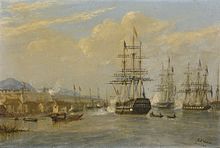
Back اچاماس کورنوالیس (۱۸۱۳) Persian HMS Cornwallis (1813) French コーンウォリス (戦列艦) Japanese HMS 콘월리스 (1813년) Korean 汗華囇號 (1813年) Chinese HMS Cornwallis (1813) ZH-MIN-NAN
 HMS Cornwallis going out of Plymouth Harbour
| |
| History | |
|---|---|
| Name | HMS Cornwallis |
| Ordered | 25 July 1810 |
| Builder | Jamsetjee Bomanjee Wadia, Bombay Dockyard |
| Laid down | 1812 |
| Launched | 12 May 1813 |
| Fate | Broken up, 1957 |
| General characteristics [1] | |
| Class and type | Vengeur-class ship of the line |
| Tons burthen | 1809 bm |
| Length | 176 ft (54 m) (gundeck) |
| Beam | 47 ft 6 in (14.48 m) |
| Depth of hold | 21 ft (6.4 m) |
| Propulsion | Sails |
| Sail plan | Full-rigged ship |
| Armament |
|
HMS Cornwallis was a 74-gun third rate ship of the line of the Royal Navy, launched on 12 May 1813 at Bombay.[1] She was built of teak. The capture of Java by USS Constitution delayed the completion of Cornwallis as Java had been bringing her copper sheathing from England.[2]
Cornwallis arrived at Deal, Kent on 31 May 1814, having escorted several East Indiamen (including Baring, Charles Mills, and Fairlie), and two whalers (including Indispensable).[3]
On 27 April 1815, Cornwallis engaged the American sloop USS Hornet (1805), which had mistaken Cornwallis for a merchant ship. Heavily outgunned, Hornet was forced to retreat. The crew threw boats, guns and other equipment overboard in order to escape.[4]

After China's defeat in the First Opium War, representatives from the British and Qing Empires negotiated a peace treaty aboard Cornwallis in Nanjing. On 29 August 1842, British representative Sir Henry Pottinger and Qing representatives, Qiying, Yilibu and Niujian, signed the Treaty of Nanking aboard her.
Cornwallis was fitted with screw propulsion and reduced to 60 guns in 1855,[1] and took part in the Crimean War, where she was commanded by George Wellesley, future admiral and First Sea Lord, and the nephew of the Duke of Wellington.
She was converted to a jetty at Sheerness in 1865. In 1916, she was renamed HMS Wildfire and used as a base ship. She was finally broken up in 1957 at Sheerness, some 144 years after her launching.[1]